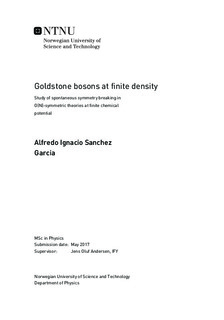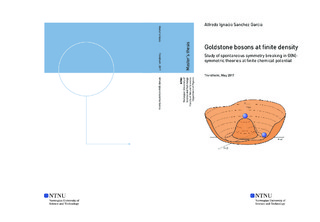| dc.description.abstract | Goldstone s theorem states that, in presence of Lorentz invariance, the number of massless modes that appear after spontaneous symmetry breaking coincides with the number of broken generators. These modes are called Goldstone bosons. In this thesis, we study spontaneous symmetry breaking in several non-Lorentz invariant theories. This includes both nonrelativistic systems and relativistic systems at nonzero density. In particular for the latter, we focus on O(N)-symmetric phi^4-theories. The method we follow is taking a Lorentz invariant system and explicitly break this invariance by coupling its Hamiltonian to its conserved charges through a finite chemical potential. Once the Lorentz invariance is broken, the remaining symmetry spontaneously breaks, giving rise to massless modes in the spectrum. We see that the number of Goldstone bosons does not always coincide with the number of broken generators. | |

